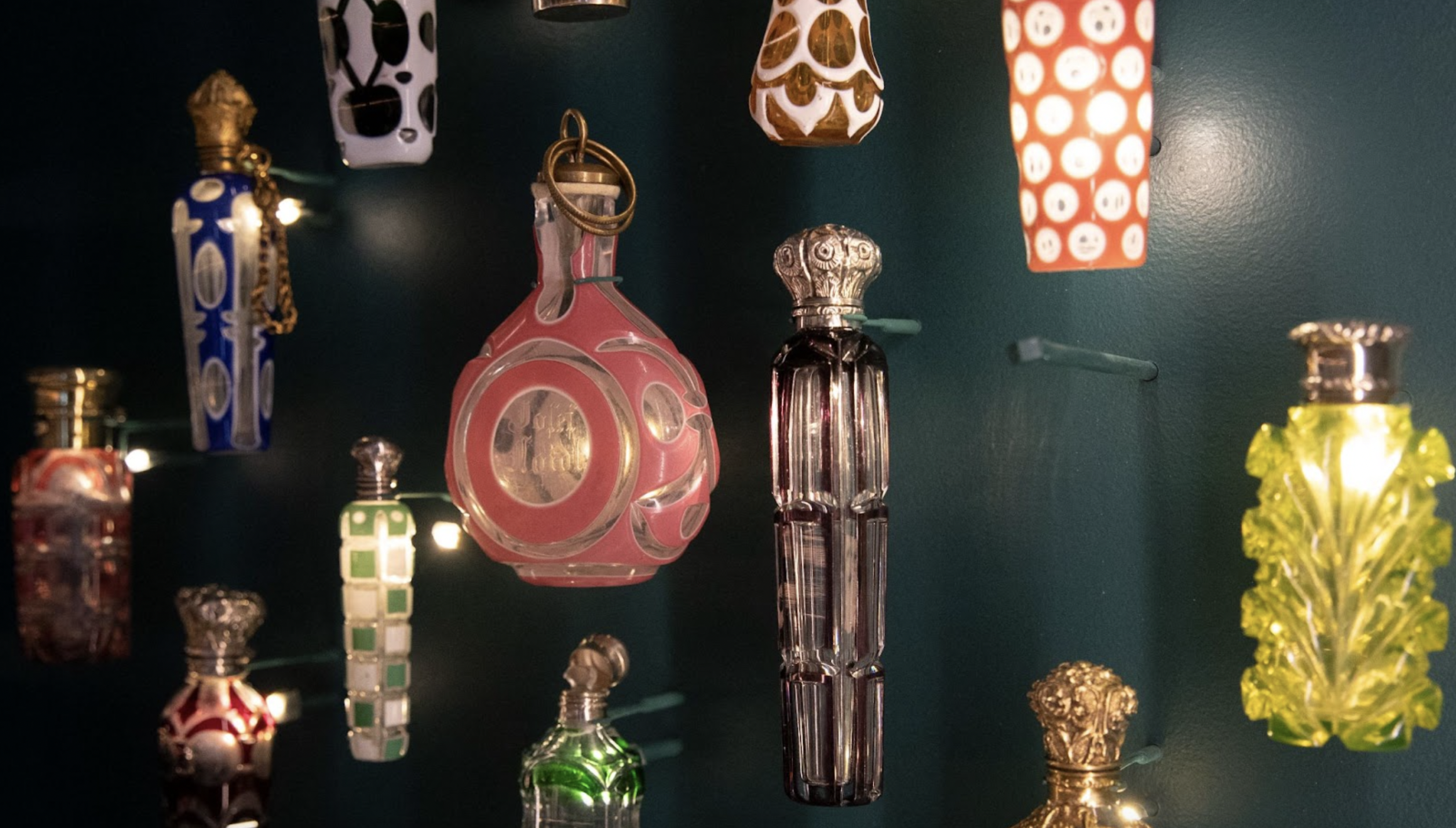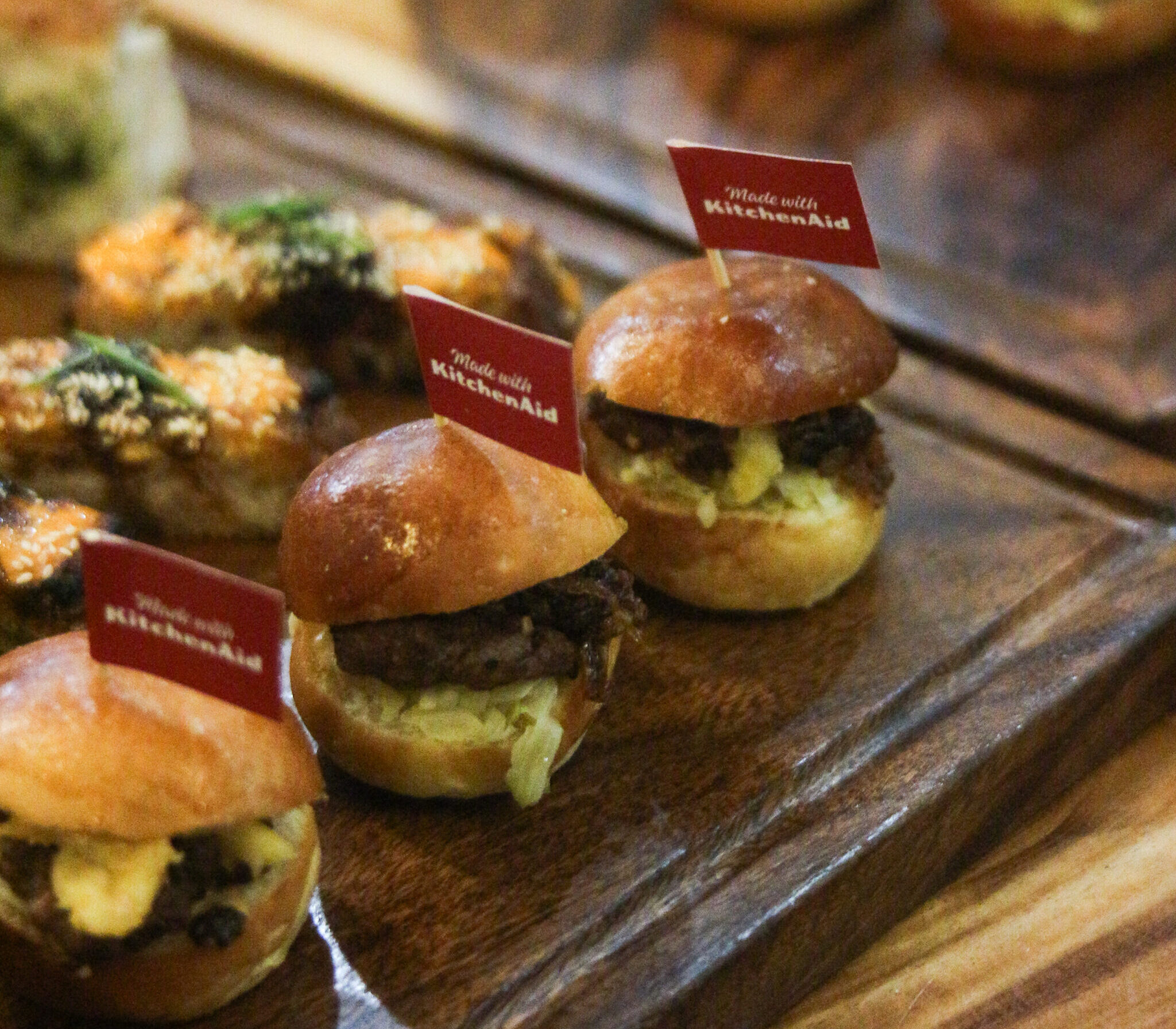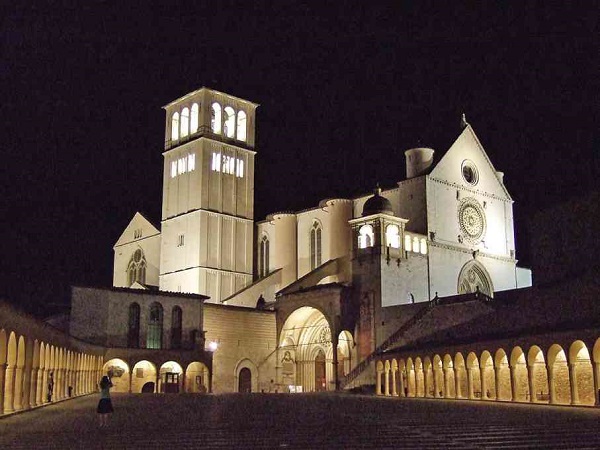
He came to me in a dream, as if in answered prayers, to give comfort and balm for a long and lingering sadness; to rouse my soul from a fitful and troubled sleep. St. Francis beckoned and so, farewell to all that, we went.
Umbria, the “green heart of Italy,” is the gentler and recondite sister of neighboring Tuscany. Where Florence, Siena and Pisa speak in florid, staccato sentences, Umbria’s Orvieto, Assisi and Perugia speak in splendid silences.
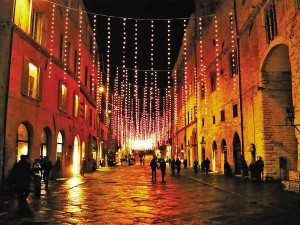
This is a small, fecund region of heart-stoppingly beautiful landscapes—still largely unspoilt—showcasing every shade of dazzling green; here and there olive and chestnut groves; dense forests of pine and poplar, elm and cypress; gently rolling vineyards.
When the sun has drained the mist that veils grey-green mountains, Umbria’s splendiferous, ancient hill towns shimmer with soft languor in the distance.
Grey stone walls and fortified battlements demarcate one medieval, but well-preserved, town or river valley from another—the rustic scenery dotted with castles, crumbling monasteries, ornate watchtowers and fortresses, Etruscan remains and relics of ancient Roman architecture.
Vertiginous, winding roads lead to steep and narrow cobbled streets and alleyways that look untouched and undisturbed by the modern world.
Time stands still.

Ideal retreat
It’s said that the world, as we know or love and hate it, is a world away for Umbria. “For many, this basic lack of interest in the world outside, combined with Umbria’s gentle beauty, makes the region an ideal retreat for the spirit,” wrote travel journalist Dana Facaros. “The greatest gift Umbria has to offer to the modern visitor is its stillness.”
In the sunshine, café tables spill out onto crowded piazzas ringing with genteel laughter and chatter—and not always about Berlusconi’s buffoonery, or Beppe Grillo’s demotic Five Star Movement, or as Italians call it, the “Vaffanculo” (aka “F… You”) political party.
Everywhere, there is much to talk and gripe about, as Italy is today one of the sick men of the Eurozone, its economy spavined and growth forecasts gloomier than a Puccini opera, but you wouldn’t know it to look around.
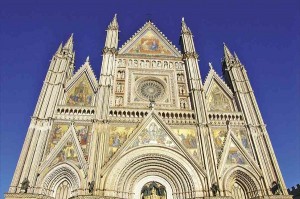
Resort and spa
We stayed at Le Tre Vaselle, a charming five-star resort and spa surrounded by vineyards in the medieval hilltop town of Torgiano.
An elegant 17th-century Umbrian villa with thick stone walls, wooden beams, vaulted ceilings, shiny terracotta floors and stone fireplaces, the hotel—owned and run by the wine-growing Lungarotti family—had just reopened after a long, hard winter, and at the time of our stay, was hosting superannuated, well-heeled American and German epicures. They have come for the region’s—and the hotel’s—food and wines.
At Le Melograne, the hotel’s stylish and award-winning restaurant, the maitre d’ handed us huge menus with the solemnity that Moses received two tablets of stone on Mount Sinai.
We were tired; we left our careworn lives behind. The hotel was somewhere eminently salubrious and exquisitely comfortable in which to rest a weary head. And because the soul has needs, a place for reflection, revival and rejuvenation (with thanks also to Daniela Steiner’s swish spa and vinotherapy).
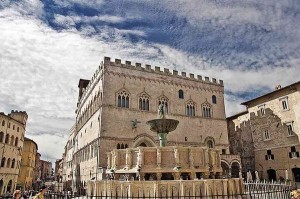
Each new morning was bathed in light, the sleepy hush broken by the singing and tweeting of larks, starlings, thrushes, doves and sparrow hawks.
With every slant of the sun, a scenery turns picture-postcard pretty. And there, in the distance, surrounded by undulating hills, was Assisi.
Thornless roses
Assisi, built high on the slopes of Monte Subasio, overlooks fertile green plains and pastoral countryside.
It is richly imbued with the spirit of Italy’s patron saint, whom pilgrims call “Il Poverello” or “Little Poor One,” despite being born Giovanni di Bernardone, in 1182, the son of wealthy cloth merchants.
In his youth as a wild troubadour engaged in “every kind of debauchery,” he wrote and performed songs and canticles.
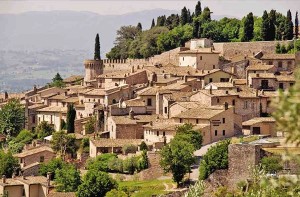
At age 21, he fought in the war between Assisi and Perugia. Defeated, he served time in jail, where he reflected upon an unjust and vainglorious world, eventually renouncing his family and their wealth, surrendering to a life of poverty, tending to lepers and serving the poor.
“Repair my house, which as you see, is well nigh in ruins,” Christ was supposed to have told him.
After receiving the stigmata, Francis preached a message of love, poverty, chastity and obedience, attracting huge bands of acolytes and followers, and founding the Franciscan Order for men, and the Order of St. Claire for women, named after 18-year-old Chiara Offreduccio, who ran away from her wealthy noble family to become Francis’ disciple.
How pleasing it is that Jorge Mario Bergoglio, former Cardinal of Buenos Aires and the 266th Pontiff of Peter’s Holy See, chose Francis for his regnal name.
In the gardens of the Cappella del Transito of the Santa Maria degli Angeli Basilica grow roses upon which Francis was said to have thrown himself while wrestling with worldly temptation, staining the leaves red with his blood, only to find that the roses lost their thorns on contact with his body. They bloom, thornless, every May.
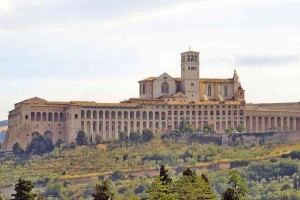
The tomb of St. Francis, who died in 1226 and was canonized in 1228, lies in the crypt of Assisi’s Basilica di San Francesco which, on any given day, swarms with hordes of devotees and pilgrims, and art lovers who gawk at Giotto frescoes.
Quite what Francis would today make of Assisi’s turbocharged and rampant commercialism and trade in trinkets and souvenirs—anything and everything from plaster saints to toy monks—we simply have to take on faith.
With mime artists robed to look like Francis and baying crowds thronging this great pilgrimage shrine, it was truly hard to find him.
So I sat down, in his church, closed my eyes, said my silent prayers, and fell asleep. I woke up minutes later to the heady scent of what looked like thousands of flickering votive candles.
Perugia
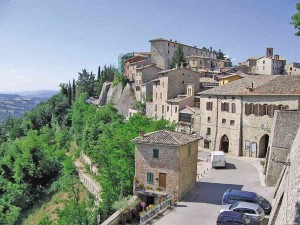
Perugia, the region’s capital city, sits majestically on a hill high above the River Tiber. It boasts two universities, with students from all over the world making up over a quarter of the population.
The media circus may have left the city, but this pretty, cosmopolitan city will forever be tainted by its notorious association with the death in 2007 of exchange student Meredith Kercher, a beautiful 21-year-old English girl, and the incarceration of Meredith’s flatmate, the American Amanda Knox (Foxy Knoxy), and her Italian boyfriend Raffaele Sollecito, who were convicted in 2009 for Meredith’s murder.
Following a much-publicized trial that to this day continues to grip lurid imagination, Knox and Sollecito were acquitted in 2011. Recently however, Italy’s highest court has ordered a new trial in a fresh appeal of the former lovers’ convictions.
In July, jazz greats including Jarrett, Marsalis and Rollins take over this lovely city for the renowned Umbria Jazz Festival. In September, during the Sacra Musicale Umbria, music of a different kind is played all over Perugia’s many churches.
We spent a few agreeable hours on the Corso Vannucci, watching a very Italian spectacle of passeggiata along a parade of shops, bars, restaurants and cafés, with the 15th-century Cathedral of San Lorenzo looming above us.
Best meals
Later, we were regaled by Claudio, the gossipy chef and owner of La Taverna, where we had one of the best meals of this vacation.
Nearby Spoleto, a walled 5th-century settlement on the foothills of the Apennines, gives Perugia a good run for its money when, in June and July, Spoleto hosts the world-famous Festival of the Two Worlds, an annual event with dance, drama, concerts and visual arts drawing thousands of visitors.
We loved the old walled town of Spello (and so would you). We arrived in this bewitchingly pretty—and chic—hill town just as the gaily-attired oompah-pah band was wending its musical way round the picturesque cobbled square.
The local delicatessen exports foodstuffs anywhere in the world; the gelateria offered several varieties of sorbets and ice cream, including pistachio which, with superlatives, you could write home about.
Faded frescoes by the Renaissance painter Pinturicchio adorn the Romanesque Church of Santa Maria Maggiore in the Cappela Baglioni.
As a nearby church tolled the knell of another dying day, you might have been tempted to say “Basta! Not another fresco in yet another church!”
This is Umbria, silly, and there are more churches than you could shake an aspergillum and censer at! They also house some of the world’s greatest artworks and frescoes of stupendous beauty, including those by Piero della Francesca, Perugino, Giotto, Gozzoli and Lorenzetti.
When everything in this life is merely on loan to us, to see and appreciate them up close seems hardly any time at all.
You go to the city of Orvieto—as we did— to admire one of the world’s most magnificent cathedrals, the Duomo.
Inside this Gothic place of worship is Luca Signorelli’s “End of the World” cycle of truly awesome frescoes with their tumultuously frightening scenes of ruin, destruction and death.
Underground city
Reflecting the fury and might of religion, the frescoes feature the Preaching of the Anti-Christ, the Resurrection of the Dead, the Last Judgment, and the Blessed and the Damned.
Make time to go down Orvieto’s underground city, dug and lived in over a period of 2,500 years, where an ingenious labyrinth of hidden caves and tunnels, galleries, grottos and passageways that were once attached to the homes of noble families, give up their ghosts and secrets.
Encircled by Roman walls, on the banks of the Tiber, is the tiny but very pretty town of Todi, which is popular with wealthy Americans who come to buy up the town’s remaining castles and villas.
There must be something in the Umbrian water, or the air, for scions of very rich families to renounce their wealth and titles, to recluse themselves from the world in a life of abstinence and prayerly devotion.
Todi is the home of one of Italy’s great, uncanonized saints: Jacopo dei Benedetti, a former lawyer who became a wandering ascetic and Franciscan friar.
“St. Francis of Assisi’s doctrine of mystical love for all creation seems to come out of the soft, bluish-green hills of Umbria, which has proved a fertile land for saints, producing a bumper crop, not only St. Francis and St. Clare, but St. Benedict, the founder of monasticism; St. Rita, the saint of impossibilities, and St. Valentine, the patron of lovers,” wrote Facaros. “Umbrians go to visit their relics the way we would call on a fond uncle or aunt.”
It’s said that while French cuisine draws attention to the chef, Italian cucina draws attention to the food. And in foodie-heaven Umbria, we ate very well, indeed.
Truffles
Truffles, grown under forest floors and covered by moldy leaves, were generously grated over omelettes and pasta dishes. Lungarotti’s Rubesco and Montefalco’s Sagrantino wines were pleasingly robust.
Norcia, widely acclaimed for its butchers, is universally noted for its legendary salumi—prosciutto, capocollo (spicy ham dry-cured with peppers and garlic), le palle del nonno (wild boar salami or “grandad’s balls”).
Umbria is also the home of pecorino cheese (from sheep’s milk), strangozzi and pici pasta, budellaccio (smoked pig’s offal), mazzafegati (pig’s liver sausage), pancetta ham, and lots of deer and wild boar.
We nearly lost our way, driving in the dark through the steep, winding roads of Miralduolo in Torgiano, looking for Osteria i Birbi, which came highly recommended. Hungry as sin, we sauntered into the restaurant, ready with our apologies for being late when we were loudly and warmly welcomed like long-lost children by the owner.
The meal was deliciously epic (so we went back there again, and again).
There were other places to see—Gubbio and Lake Trasimeno—but you could overdo this thing and travel then becomes the ruin of all happiness.
So, we only saw as much as we wanted of this idyll of eternal hills, savoring with curious minds and grateful hearts the spectacular as well as the small things. Thoroughly pampered, we slept, ate and traveled well.
Mad with happiness—a warm feeling not unlike a religious consolation or a sacred embrace—it was time to go home.
Days later, we would smile and look back on our favorite trattoria, the wishing wells, the price of espresso, the breathtaking hilltop views, and wished we were there again.
If a vacation can be said to teach us anything, it’s that life is but a breath, a series of revelations, some pleasing, others melancholy it would truly break your heart to contemplate: like the mystery of faith, knowing we’re a part of something bigger and better than ourselves. And maybe that’s why he came to me, in a dream.
Since you’re coming all the way from the other side of the world, plan on a two-destination vacation: Umbria and Lazio (including Rome and the Vatican City), or Umbria and Tuscany, or Umbria and the Lakes. Accommodation, to suit any budget, is plentiful: from hotels, villas and apartments, to agriturismo cottages. Hire a car, or book your guided tours. Shedloads of euros helpful, but not vital.

